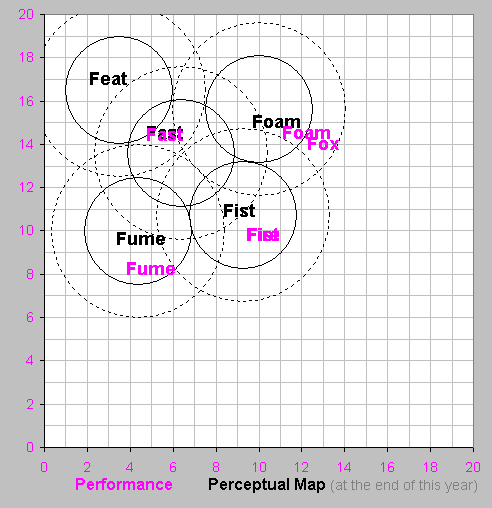12.6 Niche Differentiation - Practice Round 2
Practice Round 2
R & D Round 2
Fast - Tweak positioning to reduce age. Reduce reliability (MTBF) to reduce material cost. Example: Decrease Fast's size by 0.1 and reduce MTBF by 1000 hours.
Feat - Leave positioning alone, allowing the product to age further. Reduce reliability (MTBF) to reduce material cost. Example: reduce MTBF by 1000 hours.
Fist - Improve positioning and reduce age. Hold reliability (MTBF) steady. Example: Increase Fist's performance by 1.1. and decrease size by 1.1.
Foam - Improve positioning and reduce age. Improve reliability (MTBF) to enhance demand. Example: Increase Foam's performance by 1.4, decrease size by 0.5, and increase MTBF by 1000 hours.
Fume - Improve positioning and reduce age. Hold reliability (MTBF) steady. Example: increase Fume's performance by 0.5 and decrease size by 1.4.
New High End Product - Note that the new product's row is yellow instead of green, and that you cannot change these cells. This is because your product will not emerge from R&D until its current project completes. Under the rules of the simulation, new R&D projects cannot begin until the old one completes.
New Performance Product - Launch a new Performance product, with a project length of 20 to 24 months (no later than December of next year.) Example: Name: Fox (replace the first NA in the list), positioned beyond the leading edge of Performance segment, say performance 13.0, size 14.0. Set MTBF near the top of the Performance reliability (MTBF) range: MTBF 26000.
Important: Under the rules of the simulation, the names of all new products must have the same first letter as the name of the company.
Important: Under the rules of the simulation, the names of all new products must have the same first letter as the name of the company.

Marketing Round 2
Fast - Hold price, promotion and sales budgets. Forecast decreased unit sales over last year because the price was not reduced to match the segment's desire for cheaper products. Example: Price $28.50, promotion budget $600, sales budget $600, and sales forecast 1000.
Feat - Reduce price, and hold promotion and sales budgets. Forecast increased unit sales due to the price cut. Example: Price $21.50, promotion budget $600, sales budget $600, and sales forecast 1400.
Fist - Drop price $0.50. Hold promotion budget and sales budget. Forecast a moderate increase in unit sales. Example: Price $39.00, promotion budget $2000, sales budget $2000, sales forecast 500.
Foam - Drop price $0.50. Hold promotion budget and sales budget. Forecast a moderate increase in unit sales. Example: Price $34.00, promotion budget $2000, sales budget $2000, sales forecast 500.
Fume - Drop price $0.50. Hold promotion budget and sales budget. Forecast a moderate increase in unit sales. Example: Price $34.00, promotion budget $2000, sales budget $2000, sales forecast 450.
New High End Product - No change required because the product will not emerge from R&D until the end of this year, and it does not have production capacity.
New Performance Product - No change required because the product will not emerge from R&D until next year.
Production Round 2
For each product, schedule production using the formula:
(Unit Sales Forecast X 1.15) - Inventory On Hand
New High End product - Buy 600,000 units of capacity by entering 600 in the Buy Sell Capacity cell. Set an automation level of 5.0.
Make no other improvements to capacity or automation at this time.
Finance Round 2
Look at the proforma balance sheet, and add together your cash and inventory accounts. Apply the following rule of thumb. Keep between 15% and 20% of your balance sheet assets in cash plus inventory. You do not care about the mix, but you do want to have adequate reserves to cover unexpected swings in inventory.
Adjust your cash position to meet the guideline from Round 1. If you are cash poor, issue additional stock to cover the investment in new capacity. If you are cash rich, pay dividends.
Do not issue current debt.
Save decisions (select "directly to the website").
